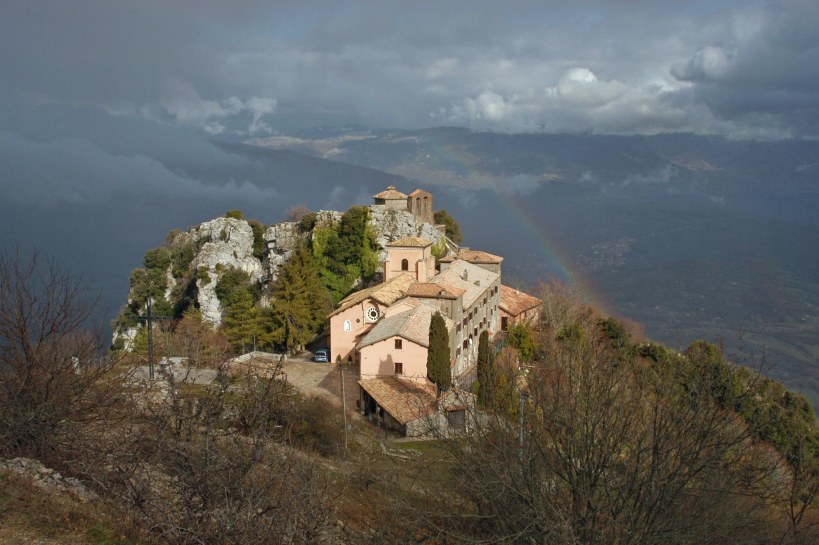

This Shrine is believed to be the oldest pilgrimage shrine to Our Lady in Italy – certainly outside of Rome. Mentorella is on a mountain about forty miles southeast of Rome, and about 1020 meters above sea level. This place, near a village known as Guadagnolo, had been venerated by Christians ever since the martyrdom of St. Eustachius around the year 118 AD, for it is believed to have been the place of his conversion, where the future martyr, while hunting, saw a vision of a deer with a crucifix between its antlers. Two centuries later the Emperor Constantine, after his own conversion and Baptism, developed a great devotion to this early martyr. Hearing that the place of his conversion was the site of many miracles and the secret devotion of Christians, he decided to honor St. Eustachius publicly by building a church at the site of his conversion.
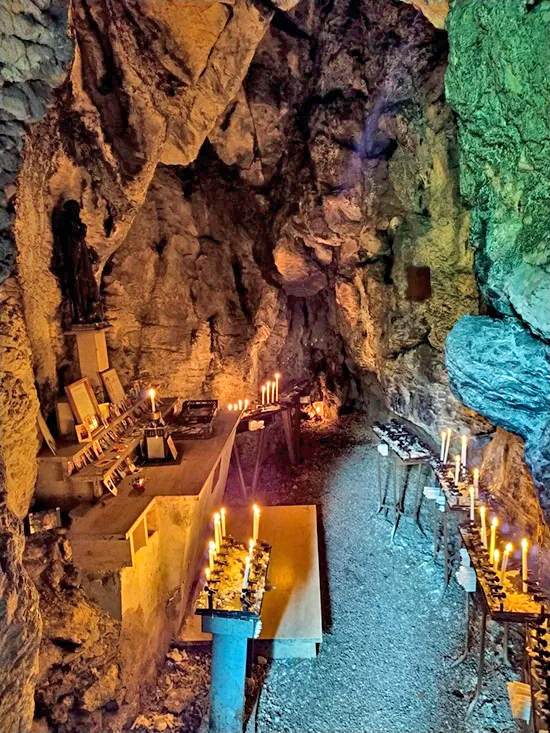 Although not far Rome, the site was nearly inaccessible. It is said that Pope St. Sylvester was blessed with an apparition
of the Blessed Virgin Mary, who admonished him to fulfill the wishes of the Emperor and to consecrate the new church in Her honor,
as well as that of the martyr, St. Eustachius. When architects objected, the saintly Pontiff replied,
Although not far Rome, the site was nearly inaccessible. It is said that Pope St. Sylvester was blessed with an apparition
of the Blessed Virgin Mary, who admonished him to fulfill the wishes of the Emperor and to consecrate the new church in Her honor,
as well as that of the martyr, St. Eustachius. When architects objected, the saintly Pontiff replied, Vult illa
(She wills it
).
The mountain itself then began to be known as Vult-illa, which later was corrupted to Vultuilla, then Vulturella,
then Montorella, and finally Mentorella. The church was indeed built and consecrated by St. Sylvester – in what year, we know not –
but certainly before the Saintly Pontiff's death in 335.
The early fervor of pilgrims unfortunately waned within the next two centuries. Then God sent the great St. Benedict to save, not only this church, but truly all of Christian Europe from the ravages of barbarian invasions. It is known that St. Benedict first lived as a hermit at Subiaco, about ten miles east of Mentorella. It is believed that he also moved his hermitage to a cave at Mentorella (image left), perhaps after the attempt on his life by poisoning, which he miraculously survived. It is also known that St. Benedict, after gathering disciples and writing his Rule for them, founded twelve monasteries on land gifted to him by his family – the Anici. Historians do not agree completely concerning their location, but there is good evidence that the abandoned church of Our Lady and St. Eustachius was the site of one of them. It is certain that eventually, a Benedictine monastery was indeed built there, and that the monks refurbished the pilgrimage church. Around the 13th century the most precious treasure of Mentorella was created – the wooden statue of the Madonna (image home page) – still venerated in the church today.
It was at the end of the 13th century that the Translation of the Holy House to Loreto took place. What was a spiritual boon to that part of Italy, was unfortunately somewhat of a disaster for Mentorella. Loreto was not only the site of one of the most marvelous miracles in the history of Christendom, but it was also much easier to reach than the mountainous Mentorella. As the numbers of pilgrims to Mentorella decreased, so also did the assistance and protection of the local nobility. Land belonging to the monastery was confiscated, and the monks found themselves in desperate straits even to feed themselves. At the end of the 14th century the Benedictine monks were forced to abandon Mentorella and join their brethren at Subiaco.
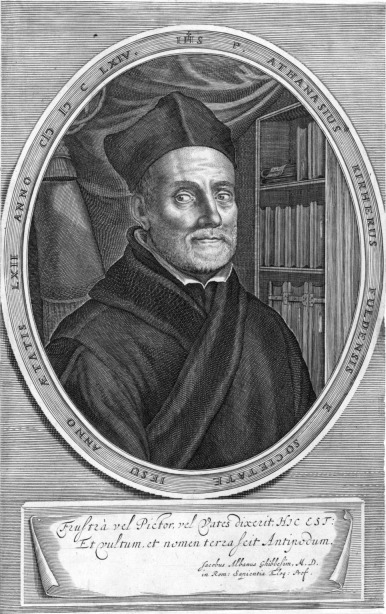 Again the church fell into ruin and oblivion. Then, in the middle of the 17th century, Mary, the Mother of Grace
called upon a famous Jesuit scholar, Fr. Athanasius Kircher, to resurrect the shrine. Born near Fulda, Germany at the beginning of that century,
He studied philosophy and theology at Paderborn, but fled to Cologne in 1622 to escape advancing Protestant forces.
On the journey, he narrowly escaped death after falling through the ice crossing the frozen Rhine –
one of several occasions on which his life was endangered. Later, traveling to Heiligenstadt, he was caught and nearly hanged by a party of Protestant soldiers.
After his ordination in 1628, Kircher soon gained renowned as a master of all arts – not unlike St. Albert the Great of the 13th century.
At an early age he had gained a reputation as a professor of ethics and mathematics, and eventually as a pioneer in Egyptology
(although his attempts to decode hieroglyphics were inaccurate, his research paved the way for future successful decoders), magnetism, geology, microbiology
(he was probably the first to believe the plague was caused by microbes), mechanical technology (his research led to the invention of the
Again the church fell into ruin and oblivion. Then, in the middle of the 17th century, Mary, the Mother of Grace
called upon a famous Jesuit scholar, Fr. Athanasius Kircher, to resurrect the shrine. Born near Fulda, Germany at the beginning of that century,
He studied philosophy and theology at Paderborn, but fled to Cologne in 1622 to escape advancing Protestant forces.
On the journey, he narrowly escaped death after falling through the ice crossing the frozen Rhine –
one of several occasions on which his life was endangered. Later, traveling to Heiligenstadt, he was caught and nearly hanged by a party of Protestant soldiers.
After his ordination in 1628, Kircher soon gained renowned as a master of all arts – not unlike St. Albert the Great of the 13th century.
At an early age he had gained a reputation as a professor of ethics and mathematics, and eventually as a pioneer in Egyptology
(although his attempts to decode hieroglyphics were inaccurate, his research paved the way for future successful decoders), magnetism, geology, microbiology
(he was probably the first to believe the plague was caused by microbes), mechanical technology (his research led to the invention of the
magic lantern
projection device), and even music theory (he invented the arca musarithmica
– a box with various rods inside which could be manipulated
to create millions of pieces of polyphonic church music randomly, even by persons with no knowledge of music – image below).
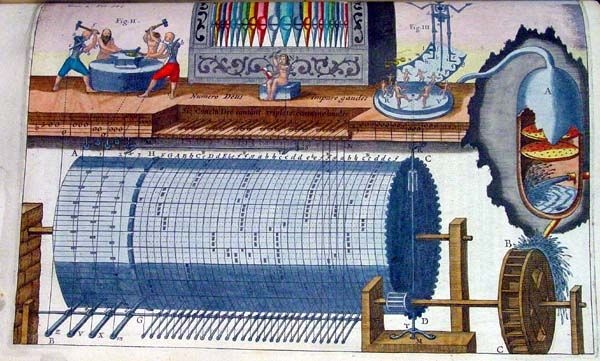 Fr. Kircher was sent to Rome in 1633, but it was not until 1661 that he discovered the ruins of the Mentorella church.
In his Historia Eustachio-Mariana he wrote of the incident thus:
Fr. Kircher was sent to Rome in 1633, but it was not until 1661 that he discovered the ruins of the Mentorella church.
In his Historia Eustachio-Mariana he wrote of the incident thus:
Dear reader: The same thing seems to have happened to me as has happened to those who, while in the cultivation of fields, root out thorns and thistles, plow up the soil, hew away stones and rocks, when by surprise, they find a treasure, which they never intended and could never hope for. It was in the twilight of life, that I began to travel far and wide through the plains, mountains, and forests of the Roman territory, with the aim of inquiring into the venerable monuments of antiquity under the guidance of ancient writings. I was hoping in the future to produce works I had already conceived in my mind, which I hoped would be of great utility, concerning Latium Vetus (the ancient name for the territory surrounding Rome) – the cities, the mountains, rivers, and especially in the surviving ruins of ancient magnificence. It was in the year 1661, therefore, when I determined to explore the mountains of Polana and Praenestinum. Beginning at Tiburus, my laborious path led by the most rugged mountains and a stretch of rocky slopes, until around midday, I arrived in a horrible solitude, surrounded by huge rocks like a crown – indeed a place full of terror – for it was as if the rocky pyramids of the mountain struck the sky with their height, the precipice of its overhanging rocks ending in dizzying chasms like the pits of Hell. At this horrible sight, not knowing how I was able to advance any further, I perceived traces of shapes, dimly manifesting themselves among the trees and rocks. Having come nearer, I discovered a church, almost collapsing with age, and open to the air. At first I was astounded at how a church could exist in a solitude so full of terror. On entering, however, I found large and complete paintings of holy images, although darkened, and even venerable carvings, all of which breathed the devotion of ancient piety. In the middle of the church an altar was to be seen surrounded by an iron grate; upon which was a wooden statue of the Mother of God supporting Her Son with Her arm. Although eroded by age, as well as covered with dust and cobwebs, yet gazing upon Her I was moved in a strange manner... I do not know by what internal devotion, but I was inflamed with the resolution... to undertake a pilgrimage to the same place every year, and to do everything my poverty would permit to obtain the desired contributions and everything that seemed most necessary in order for the church to be renovated and adorned. Turning from here to the walls, I discovered various inscriptions and sketches of pictures – from which I finally learned clearly that this was the same place in which the wonderful conversion of St. Eustachius to God had occurred; which had also provided the opportunity to found a church here, dedicated to the worship of St. Eustachius and the Mother of God. Thinking to examine the matter more exactly, I went to a village near the foot of the mountain, which is commonly called Guadagnoli, where I learned from the local priest, Francisco Capitosto, an excellent man, as minutely as possible about everything and every detail...
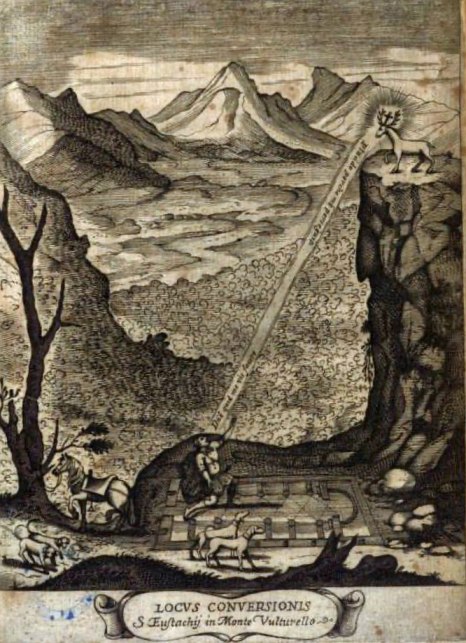 Fr. Kircher later reported how the Virgin Mary had spoken to him when he first visited Mentorella in 1661:
Fr. Kircher later reported how the Virgin Mary had spoken to him when he first visited Mentorella in 1661: See how I am neglected here in this wilderness?
Nobody cares about Me, nobody cares about My church and this sacred place, where I was venerated so much by people in earlier times.
Fr. Kircher vowed to ensure
that Her sanctuary would be restored. His vow was immediately rewarded: When I returned home I found a letter enclosed in a letter, through which the most
well-to-do Duke of Braunschweig-Lueneburg had granted me 400 Roman thalers to promote my studies, with unusual generosity worthy of such a prince.
I recognized a hidden hint from the Mother of God, put aside all other studies, and was by no means idle, but started the story of this holy place under the title:
Historia Eustachio-Mariana.
(Nikolaus Seng, Herzog August, Athanasius Kircher und das Geld
, University of Würzburg).
Lending the same genius to this subject as he did to others, he published the Historia Eustachio-Mariana (see image left) in 1665,
and was able to raise funds for the renovation of the church. He restored the devotion to Mary, Mother of Grace and reestablished the Shrine as a place of pilgrimage.
Not surprisingly, he equipped the Shrine with one of his many inventions – a series of speaking trumpets
or megaphones, which could be heard for miles away
and were aimed at each neighboring village. When he died in 1680, he asked that his heart be buried in the church. Pope Innocent XIII, who was the Pope at the time,
also requested that his heart be buried in the church.
In 1857 Pope Pius IX placed Mentorella under the care of the Congregation of the Resurrection, under the guidance of Fr. Kajsiewicz.
The General Chapter of the Congregation of the Resurrection (1864) was held at Mentorella. In 1864, the Holy Father ceded the Sanctuary of Mentorella
to the Congregation of the Resurrection in perpetuum
. With the fall of the Papal States the Congregation of the Resurrection purchased the shrine
and acquired legal title to it.
A proper Mass in honor the Blessed Virgin Mary, Mother of Grace was inserted in that portion of the Missale Romanum known as Missae pro aliquibus locis – Masses for various places, under the date June 9.
Alphabetical Index; Calendar List of Saints
Contact us: smr@salvemariaregina.info
Visit also: www.marienfried.com